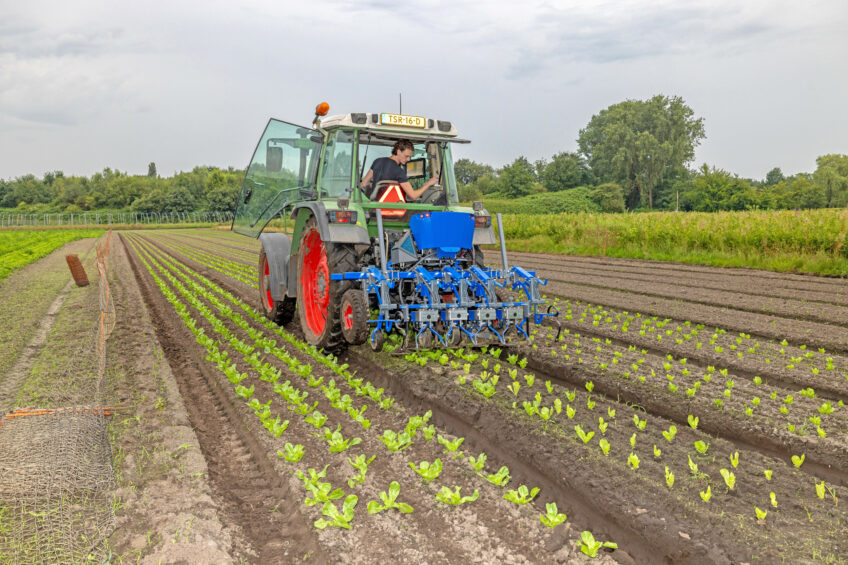E-Vario-Weeder hoeing machine ready for practical use

Future Farming observed the E-Vario-Weeder from Eerke Lauwen at work in endive fields. This hoeing machine is an impressive piece of Dutch engineering. It is ready for use in lettuce and endive cultivation, and development has started on software for other crops, like sugar beets.
The E-Vario-Weeder uses camera guidance to hoe within rows. The camera software identifies the crop plants, ensuring that the machine follows the row precisely. It hoes nearly the entire surface, both between and within the rows. The development started in 2018, and now the machine is ready for the market.
Electric drive
Two flat hoes move towards and away from each other within the row. Where there is no lettuce or endive, the blades move towards each other and hoe everything. Each pair of rows has its own camera. When the software detects a crop plant, the blades move apart to leave it intact. The first prototype used air cylinders to move the blades, but while air is adjustable, it wasn’t precise enough. The electric system is simpler and much more precise. In crops like endive and iceberg lettuce, it’s crucial that the hoes don’t throw soil onto the leaves, which could later affect the crop heads.
The blades move quickly yet subtly, as the speed can be adjusted in fractions of seconds with the electric system. Users can set how far apart the blades move. For larger plants, this can be further apart to avoid damaging leaves. You can also set how far in front of and behind the plant the blades open and close, allowing you to control how close to the crop you want to hoe. The machine can achieve speeds of 1.5 to 2.5 km/h with a plant spacing of 25 cm. The minimum plant spacing for hoeing with reasonable capacity is 10 to 15 cm. Settings are easy to adjust, simply using virtual sliders on a tablet.
Hoe developed in practice
Eerke Lauwen, the son of a vegetable farmer, developed the hoe out of practical need. “We were struggling with certain weeds in endive and iceberg lettuce, and labor costs were becoming a concern,” Eerke explains. “That led us to think about a hoe that could work within the row. At the time, there wasn’t much available to buy, and we had specific needs. With my background as an engineer from Wageningen University, I saw an opportunity to turn that knowledge into a working machine.”
Starting point: build it as simple and light as possible
The E-Vario-Weeder’s principle is straightforward: a camera identifies the crop plants, and the hoe blades move in and out of the row accordingly. The camera technology is based on artificial intelligence (AI). The quality of the algorithms that recognize the plants largely determines how well the hoe works. Plants change shape during different growth stages, and damage from hail or pests can occur. The software must learn to recognize these changes. The E-Vario-Weeder is well-developed for lettuce and endive, and further development for other crops is ongoing.
Text continues below picture

Relation with Fendt
The name E-Vario-Weeder, first seen behind the fully electric Fendt e107 Vario at the Agritechnica show, suggests a Fendt development. However, despite some collaboration, the machine is entirely Lauwen’s invention. He is now both inventor and manufacturer. The Weeder has its own hydraulically powered generator to drive the electric blades. This provides constant power through a buffer battery, ensuring reliable electricity for the electronics.
In combination with the Fendt e107 Vario, the tractor supplies the power, eliminating the need for a generator. This is more energy-efficient, as it avoids the need to drive a hydraulic motor. In practice, the electric Fendt can operate for about two hours longer per battery charge when using a hoe without a generator.
Further development
The guiding principle was to keep the design as simple and lightweight as possible. The frame, sideshift, and parallelogram systems were custom developments. A small, simple tractor can operate the machine, and it works as intended. The controls are also easy: activate the sideshift on/off, set safety zones (distance before and after the crop plant for opening and closing), and adjust the threshold—how confident the software must be that it recognizes a crop plant. If set at 80%, and the software is only 70% sure it’s lettuce or endive, the plant will be treated as a weed.
Text continues below picture

Although the machine is ready for practical use, development continues. Other crops present challenges, and the maximum working width is currently 6 meters. There are also plans to develop a system that hoes in a rotating motion around the plant to increase the cultivated area. Lauwen is also working on establishing production, sales channels, and after-sales service.



